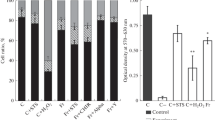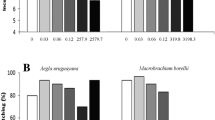Abstract
The influence of low concentrations of 10-(2′, 3′-dimethylhynonil-6′)-deciltriphenylphosphonium bromide on the laboratory culture of the crustaceans Ceriodaphnia affinis has been investigated. The increase of average and maximum lifespan, as well as stimulation of heredity, has been found out. Possible mechanisms of this phenomenon have been analyzed.
Similar content being viewed by others
References
Vrochinskii, K.K. and Shcherbakov, Yu.A., Assessment of the Effect of a Compound on Aquatic Organisms with Allowance for the Toxicity Staging, in Teoreticheskie problemy vodnoi toksikologii. Norma i patologiya (Theoretical Problems of Aquatic Toxicology: Normalcy and Pathology), Stroganov, N.S., Ed., Moscow: Nauka, 1983.
Filenko, O.F. and Isakova, E.F., Compensatory changes in the response of Daphnia to lethal impacts, in Reaktsii gidrobiontov na zagryazneniya (Responses of Aquatic Organisms to Pollution), Moscow: Nauka, 1983, pp. 135–139.
Laughlin, R.B., Ng, J., and Guard, H.E., Hormesis: a response to low environmental concentrations of petroleum hydrocarbons, Science, 1981, vol. 211, pp. 705–707.
Stebbing, A.R.D., Hormesis—stimulation of colony growth in Companularia flexuosa (Hyrozoa) by copper, cadmium and other toxicants, Aquat. Toxicol., 1981, vol. 1, no. 3, pp. 227–238.
Steevens, J.A., Duke, B.M., Lotufo, G.R., and Bridges, T.S., Toxicity of the explosives 2,4,6-trinitrotoluene, hexahydro-1,3,5-trinitro-1,3,5-triazine, and octahydro-1,3,5,7-tetranitro-1,3,5,7-tetrazocine in sediments to Chironomus tentas and Hyalella azteca: low-dose hormesis and high-dose mortality, Environ. Toxicol. and Chem, 2002, vol. 21, no. 7, pp. 1475–1482.
Selie, H., Ocherki ob adaptatsionnom sindrome (Essays on Adaptive Syndrome), Moscow: Meditsina, 1960.
Filenko, O.F., Dynamics of the Impact of Pollutants in Ecotoxicology, Toksikol. Vestnik, 2001, no. 2, pp. 2–6.
Gershkovich, D.M., Filenko, O.F., and Isakova, E.F., Potential toxicants as a tool for stimulating vital functions of aquatic organisms, in Mater. IV Vseros. Konf. po vodnoi ekotoksikologii, “Antropogennoe vliyanie na vodnye organizmy i ekosistemy”, posvyashch. pamyati B.A. Flerova, Borok, 24–29 sentyabrya 2011 (Proc. IV All-Russia Conf. on Aquatic Ecotoxicology “Anthropogenic Impact on Aquatic Organisms and Ecosystems in Memory of V.A. Flerov, Borok, September 24–29, 2011), Borok: Papanin Inst. Biol. Vnutr. Vod Ross. Akad. Nauk, 2011, pp. 24–29.
Metodicheskie ukazaniya po ustanovleniyu ekologorybokhozyaistvennykh normativov (PDK i OBUV) zagryaznyayushchikh veshchestv dlya vody vodnykh ob“ektov, imeyushchikh rybokhozyaistvennoe znachenie (Guidelines for the Establishment of Ecological and Fishery Standards (MAC and AAC) of Pollutants in Water Bodies of Fishery Significance), Filenko, O.F. and Sokolova, S.A., Eds., Moscow: VNIRO, 1998.
Filenko, O.F., Isakova, E.F., and Gershkovich, D.M., The lifespan of the cladoceran Ceriodaphnia affinis Lilljeborg in a laboratory culture, Inland Water Biol., 2011, vol. 4, no. 3, pp. 283–286.
Anisimov, V.N., Bakeeva, L.E., Egormin, P.A., Filenko, O.F., Isakova, E.F., Manskikh, V.N., Mikhel’son, V.M., Panteleeva, A.A., Pasyukova, E.G., Pilipenko, D.I., Piskunova, T.S., Popovich, I.G., Roshchina, N.V., Rybina, O.Yu., Saprunova, V.B., Samoilova, T.A., Semenchenko, A.V., Skulachev, M.V., Spivak, I.M., Tsybul’ko, E.A., Tyndyk, M.L., Vysokikh, M.Yu., Yurova, M.N., Zabezhinskii, M.A., and Skulachev, V.P., Mitochondria-targeted plastoquinone derivatives as tools to interrupt execution of the aging program. 5. SkQ1 prolongs lifespan and prevents development of traits of senescence, Biokhimiya, 2008, vol. 73, no. 12, pp. 1329–1342.
Isakova, E.F. and Yukleevskikh, M.Yu., Seasonal changes in the resistance of D. magna laboratory culture to potassium bichromate, Biol. Vnutr. Vod, 1998, no. 3, pp. 76–82.
Shcherban’, E.P., Toxicity of some heavy metal ions for Daphnia magna Straus depending on temperature, Gidrobiol. Zh., 1977, no. 4, pp. 86–91.
Author information
Authors and Affiliations
Corresponding author
Additional information
Original Russian Text © D.M. Gershkovich, E.F. Isakova, O.F. Filenko, T.A. Samoilova, 2013, published in Vestnik Moskovskogo Universiteta. Biologiya, 2013, No. 3, pp. 27–30.
About this article
Cite this article
Gershkovich, D.M., Isakova, E.F., Filenko, O.F. et al. Increasing viability of the crustacean Ceriodaphnia affinis Lilljeborg using 10-(2′, 3′-dimethylhynonil-6′)-deciltriphenylphosphonium bromide. Moscow Univ. Biol.Sci. Bull. 68, 115–118 (2013). https://doi.org/10.3103/S009639251303005X
Received:
Published:
Issue Date:
DOI: https://doi.org/10.3103/S009639251303005X




